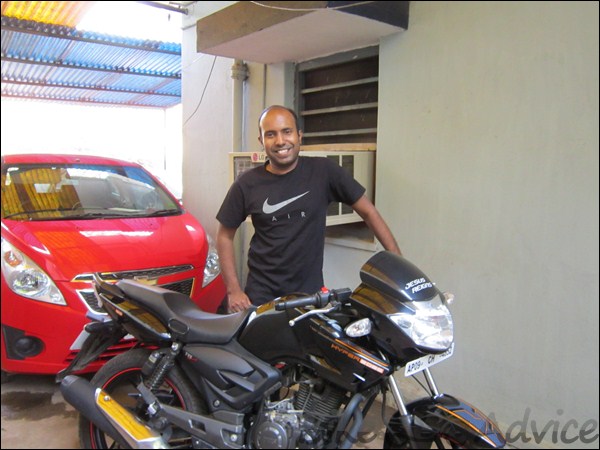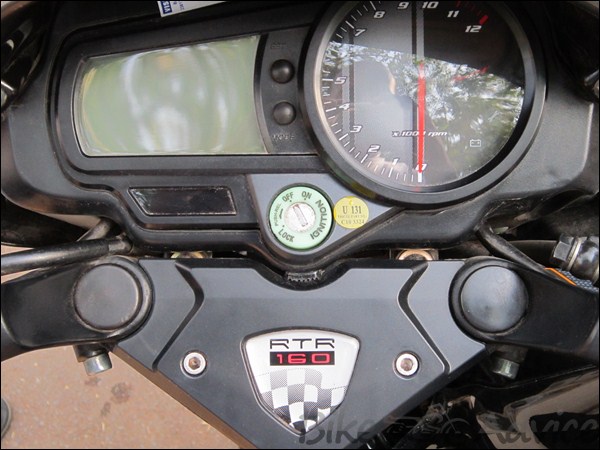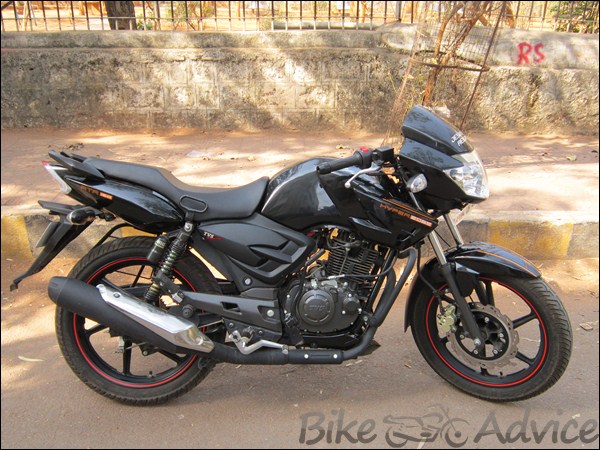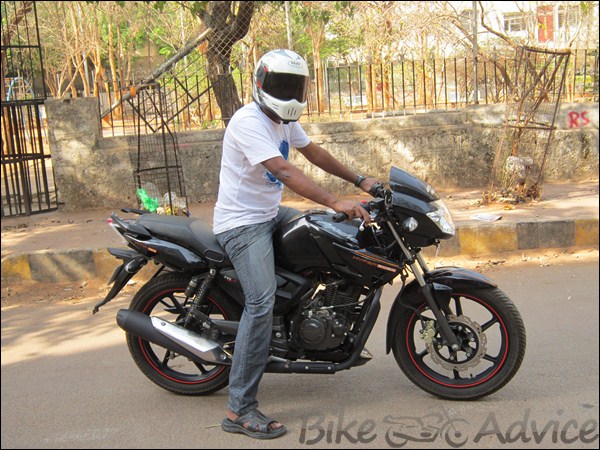Hi there, I’m Dinesh, a 30-year-old editor employed in the medical transcription industry. I am a thorough-bred auto enthusiast whose joy knows no bounds as the Indian Motorcycling Industry prepares to scale new heights and enter a whole new realm with the power bikes steaming in.

However, currently I want to give you a practical review and overview of the current premium bike segment, having shared the experience of owning a Pulsar 180 and now an Apache RTR 160. This review is purely from an everyday commuter point of view. I work from home, so there is not much traveling to be done on a daily basis until I decide to take my bike out for a spin once in a while.
This is more of a practical comparo study that I had done before zeroing in on the new Apache RTR 160 Hyper Edge. First let me share with you my experience with the Pulsar. I had a glimpse of the Pulsar 180 in the 8th Auto Expo in the year 2006. It was an out of the box experience to see the radical design, macho looks, and state of the art technology.
This move by Bajaj took motorcycling to a whole new level in India. I am really proud that an Indian bike maker took the initiative rather than some alien company from abroad. I waited nine months until the pro-biking outlet was launched in Hyderabad and the first bike to premier in these outlets was the P-180. I purchased it for Rs. 64,500 on-road, which was nothing less than a steal.
The engine was nice and smooth. The throttle response was light and crisp. I fell in love with it almost instantly. Little did I know that my love was not going to last long. The shoddy after sales service was a great disappointment. The service center was pretty far from home and moreover the service rendered was not at all up to the mark. I would say the bike was excellent, but the service front was a total let down.
Every time I went for my scheduled service, there were numerous angry customers having an argument with the service personnel. Then came a time when the pro-biking service station refused to accept P-180s for servicing with the introduction of P-200 and P-220. When I approached the nearest authorized dealer, the service rendered was even more horrible. The mechanics demanded heavy tips to do their job.

The digital speedo started to give way within two years of purchase. The electricals went out within two years, that too with me using the bike very sparingly. There was a problem with the horn switch and the mechanic at an authorized service had told me I needed to replace the twin horns. Fortunately, I went for a second opinion and just needed to replace the horn switch. There was a problem with the self-start and I was told I needed to change the battery while I had just replaced the battery a month ago.
Again, a second opinion seemed to resolve the issue with no major repairs. Mind you, all this experience is at an authorized Bajaj dealership, which also happens to be one of the oldest and largest in Hyederabad. These problems lasted until I finally got fed up and sold the bike this year. What was worse was the resale value.
A bike that had run only 16,000 km and maintained well with periodical service was quoted a bare minimum of 20-25k by one of the leading Bajaj dealers in Hyderabad. My heart was broken. Pulsar, claimed to be India’s #1 sports bike doesn’t even sell for half its ex-showroom price at the end of six years was a bit of a shock. The reason for me mentioning all the above is that you do not get to read this stuff on regular reviews.
We see people raving about the bike’s design, performance, mileage, pick-up, etc., but what about the resale value. A middle class man who shells out nearly 80k these days to acquire a bike in the premium segment is not even guaranteed half the price at the end of five years of its use. Now, here is an honest comparo I made myself with the info available on the net before buying the Apache RTR 160.
First on my list of review was Yamaha. I am an ardent fan of Yamaha and was truly perplexed when the company went nearly bankrupt after a series of flop models. Come 2009 and the emperor struck a hard blow and returned with a bang. Enter the Fz16 and R15. These two models changed their course totally and they are well and truly in the race currently. As far as I was concerned, R15 was way beyond my budget.
Coming to FZ16, the major drawback this bike suffers from is the mileage. Many of my friends who own this bike have shared with me that the average mileage is around 35-40 km/L. With the sky-rocketing fuel prices, this is a major concern. Also the pillion seat is not that spacious for ladies to sit. Now that I am married, I had to consider this fact as well.
Some of my friends also complained of back pain after riding this bike over longer distances. I sincerely felt this bike was good, but did not fit my criteria. The main thing that really irritated me was the Yamaha dealer was not even ready to give a test ride. How are we supposed to buy a bike without a test ride? He offered me to test his own bike, which appeared well advanced in its age and was falling apart all over. I hope Yamaha people are reading this.

Secondly, I knew Bajaj was going to launch a new, bigger, and better Pulsar celebrating their 10th anniversary. Though my heart goes out to Bajaj for having created a revolution in the Indian biking industry, with the bitter experience of their after sales service and peanuts resale value, I had to flush the pulsar mania out of me. We all know that the Pulsar 200 NS is here, but we do not know how effective it would be in real conditions with its triple spark plug technology, four valves, mono-shock, and of course the central exhaust.
Thirdly, since my first bike was a Hero Honda Splendour, I gave a thought to CBZ Extreme as the new model came fully loaded with 10-spoke alloys, digital speedo, split seats, engine crowl, gas shocks, and clip-on handle bars. My Spledour had lived up to its expectations – smooth engine, good mileage, and good resale value when I sold it in 2006 after using it for five years.
The reason I overlooked the CBZ was that it was just as heavy as my outgoing Pulsar weighing around 143 kgs and not all that easy to maneuver in city traffic. Also, personally I am only 5’6″ and thought it would not suit me all that well. Also I was suggested by my friend who works for Hero Moto Corp not to go for this bike. Instead, he suggested Karizma, but my budget was a major factor here.
Fourthly, Honda Unicorn/Dazzler. The major problem with Honda is everything and anything is considered an accessory, for example even the number plates. Then there is the waiting period and I find the models a little pricey for the things they have on offer. They are not all that eye catchy.
I did visit a Suzuki dealer to inquire about the GS150R, but they did not even have the bike on display, so this was ruled out.
Finally, I went to a TVS dealer. I had made up my mind to go for an Apache RTR 180. I had done enough research and read many reviews, both good and bad. My only concern was the mileage. I had read in many reviews that the mileage of the Apache 180 was not all that great. Also the price was staring right in my face every time I considered this particular model.
At 82k (on-road) I found it way too overpriced. The dealer who happens to be a close friend suggested me to go for a 160 instead. He said the 180 had some problems with the rear disc not functioning all that well and not lasting long. He said the 160 had better resale value and almost all the features were same in both the models except for the tubeless tyres, rear disc (optional in 160, need to pay Rs. 2500 extra), and increased wheelbase by about 20 mm. Here’s my experience with the bike until now. First free service is over. The ODO reads around 800 km. The bike is now two-and-a-half months old. Now section wise review:
Looks
Gone are the days when ordinary looking bikes used to roam the streets. Now macho and sporty looks are a must even for an average customer. The Indian biker has grown up and is no longer satisfied by a few sticker jobs or paint jobs to enhance the looks of a bike. As far as looks are concerned, though the Apache is quite old, it still looks fresh.

May be one of the reasons for this is the engineers at TVS planned well ahead of time when they launched this model a few years back. We have seen Pulsar getting quite a few makeovers and the launch of FZ from Yamaha, but Apache seems to be in a league of its own. The air scoops that were added in the year of 2008 are well designed and the racing stripes on the bike and red ring rims enhance the overall look of the bike.
I purchased a black one because I didn’t feel like shelling down 1k more for the yellow one. Now, even the 160 comes with black clip-ons, which in turn adds stealth looks to the bike because there is hardly any chrome you find on the bike. Overall, I feel the Apache looks as fresh as it did when it was launched a few years ago; no wonder the engineers do not want to meddle with its design yet.
Comfort
This was an important factor for me, as I was looking for a bike that wouldn’t give me any wrist pain or a backache after riding a reasonable distance. This is where the weight comes into picture. The Apache weighs just 136 kgs with a power to weight ratio of 129.6, which makes it light and nimble.

After using a P-180 for nearly six years, this bike feels really light weight and there is hardly any wrist pain or back pain after riding this bike. Mind you, much of it depends on the posture you decide to take. If you ride in a racing posture, you are bound to develop backaches. One needs to position himself nicely on the seat and maintain a relaxed upright posture in order avoid both back and wrist pain.
The shock absorbers are not as soft as those in the P-180, though both are gas-filled. I feel P-180 has the best shocks in this segment. I feel the shocks are purposely made a bit stiff to go with the racing concept of the Apache. The clip-ons and the switches are well placed. The seating for the pillion is certainly more spacious when compared to FZ, but not as spacious as the P-180. Also, the Apache is meant strictly for city riding. It will not come in handy for highways.
Handling
I had taken a test ride of the Apache 180 and was totally bowled over by the ride quality. It was so smooth and maneuvering in the traffic was a piece of cake. I see many people mentioning the fact that the more they ride an Apache, the more they feel like riding it and I must say I agree with them 100%. Nothing much changed with the 160. I have heard many complaints about vibrations.

When it comes to 180, it is totally vibration-free unless you are bent upon breaking the land speed record. With the 160, vibrations last until the first service, i.e., at regular speeds of 40-60. This is mainly due to the harsh firing/beating. One can reduce the vibrations by twisting a screw right under the seat, but it is better we leave such things to the mechanics. They do advise to bear with it until the first service.
After the first service, the firing is reduced and the ride is much smoother. I would not say as smooth as the 180, but it is not all that shaky until speeds up to 60. I haven’t gone past that speed, so cannot comment anything beyond that. Also one needs to make sure he rides in the right speed in the right gear. The Apache has very short gear ratios and the faster we shift to the top gear, the sooner we rid ourselves of the vibrations.
Acceleration/Pick-Up
The high power to weight ratio of 111.76 does its part in this section. The pick-up and throttle response is almost instant. It is so quick that it will almost throw the pillion overboard if one is not bracing himself/herself. With the shorter gear ratios, shifting to the top gear is lightning quick and one surely misses a sixth gear. I hope TVS people read this. There have been several instances where I have reached the fifth gear in almost no time and kept searching for the sixth. This issue was mentioned in an Apache 180 review and I would say same is the case with the 160.
Mileage
“Kitna deti hai,” one must admit that every Indian has this question at the back of his/her mind whether he/she is buying a motorcycle or scooter or a car. The sales executive at the dealership was very frank when he said that it would give around 45km/L. I thought 45 was a reasonable figure bearing in mind the fact that I do not travel much on a daily basis.
The reason I decided against the Apache 180 was because its mileage figures read somewhere around 35-40. I haven’t done a foolproof test, but I think I am getting a mileage a little over 45, which is a good sign. I am sure it will increase slightly after the second and third services.
Maintenance/After Sales Service
This was the main reason that killed my confidence in Bajaj. Coming to TVS, though the dealer is a good friend of mine, I took time to watch how they dealt with regular customers and I was pretty satisfied. Though I cannot comment on the quality of electricals and their service until significant amount of time has lapsed, I can assure you that their approach is much better. However, this might not be the case with all dealerships. The spares almost cost about the same for both Bajaj and TVS bikes, but are a bit more expensive when it comes to Yamaha or Honda.
Value For Money
At around 76k on-road in Hyderabad, I think it is a bit pricey, but when one does look around, every other bike in this segment either shares the same price tag or may be a grand or two more than this. The P-150 is around 77k. FZ16 costs around 3K more than this. All in all, I feel you wouldn’t have wasted your money just in case you opt for the Apache.
This is just an honest and sincere effort to help people like me who are looking to buy a new bike in the 150-160 segment with a budget of around 75-80k. You may find this review a bit lengthy, but I have tried to cover almost all the points that I learnt from reading several reviews and expert comments and shootouts by leading auto experts.
I just hope it helps you out and an important fact is that a bike needs to cater to each one’s personal needs. The choice is ultimately personal because each one has a different lifestyle. That’s it from me for now guys. Ride safe, always wear a helmet, put the headlight on low beam while riding in the city limits, and please do not use your cell phone while riding.
God bless.
Regards,
Dinesh


